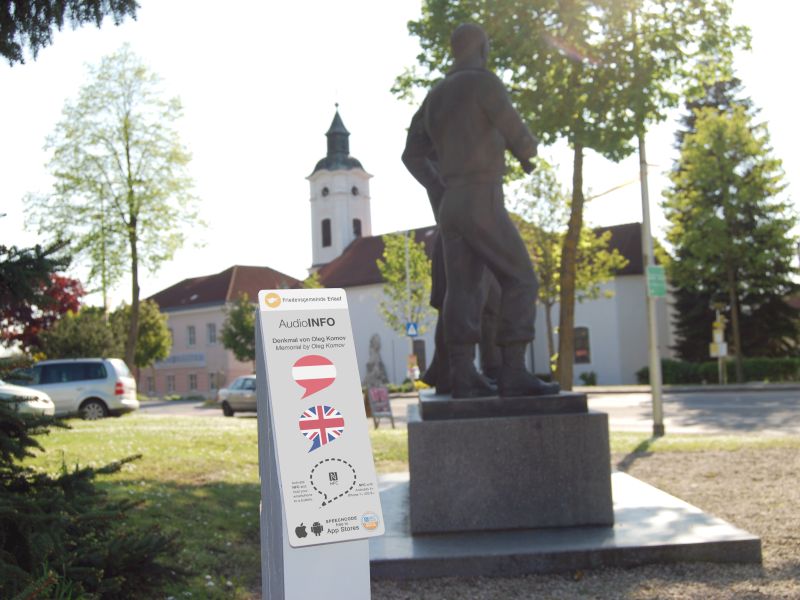Even today, we see great efforts in the important task of history and culture interpretation.
With detailed information boards, books, illustrations and audio guides. But also interactive installations and, of course, personal, expert guides.
Meanwhile, voice assistants are becoming increasingly popular. So it makes sense to use them for history interpretation:
It is much more difficult to communicate history in public spaces than in museums.
Because monuments, historical buildings, squares, and even entire villages or coastlines have one thing in common:
They are freely accessible 24/7, i.e. without opening hours or a central entrance.
And very often without electricity or network access nearby!
Nevertheless, the history interpretation directly on site should work the same way as indoors, but 24/7 and completely (cost)free.
Without extra equipment, complex infrastructure or even personal support.
So far this meant – in the best case – the mounting of info boards.
However, it is hardly possible to explain historical contexts adequately and comprehensibly on such signage.
In addition, the willingness to read is declining, especially among younger people.

Audio texts offline and for your own smartphone: Ideal for innovative history interpretation in public spaces!
There is a reason that audio guides are considered “unbeatable” in culture and history interpretation.
Because eyes and hands remain free. And it is much more comfortable to listen to exciting stories than having to read texts.
However, audio guides mean high production costs. And they require either their own devices, or powerful Internet. This limits their use to convey history in public spaces.
Voice assistants, as we know them from Apple’s Siri and Google’s Alexa, are therefore a good alternative!
They work with a so-called TTS (text-to-speech) engine. In this process, sophisticated algorithms assemble any text from a database of words and phrases provided by professional speakers.
This ensures pleasant, clear and natural-sounding voice output.
Currently, Nuance’s TTS Vocalizer 3.5 is considered the top product. It is used by Siri, Alexa, Google and SpeechCode, among others.
Smartphones with Voice Over (iOS) and Talk Back (Android) can already read texts aloud. Provided that they are available online on a website or as PDF download. However, users must make these settings on their smartphone and be familiar with them. In addition, websites and PDF texts often have a structure, that voice assistants cannot read in the correct order.
The biggest drawback to this method, however is, that such texts are written to be read, not heard!
In order for voice assistants to do well in history mediation, it is therefore absolutely necessary to design the information for listening.
Good audio texts can then – instead of expensive studio recordings – be turned into an MP3 with a TTS, which is available for download. In this case it is important, that the files are not too large, so that their download takes little time and does not push internal memory to its limits.
But even this method of course only works if there is free and fast internet! Yet, e.g. on the beaches of Normandy or at the WW-I positions in the Soca Valley there is often no mobile connection at all.

Here, history interpretation will only work with an offline solution!
With SpeechCode, you can convey history with voice assistants even without a network connection.
So really always and everywhere, reliable, accessible, guaranteed free of charge and in compliance with all data protection regulations.
This is because smart data compression allows the entire audio text to be stored on an NFC tag. The data transfers directly from the NFC tag to the user’s smartphone. So there is no need for network access.
The free and accessible SpeechCode app shows the text on the display, reads it out aloud immediately using a voice assistant, and saves it automatically. Especially in history interpretation, it is an advantage, if the information can be called up again later.
An NFC Speech Tag is cost-effective, robust, weather-resistant and requires no power source or other infrastructure. You can even affix them to existing signs. Each NFC Speech Tag can hold up to 6 pages of A4. This corresponds to approximately 30 minutes of audio text.
The online Speech Generator enables very easy and fast production of audio files.

SpeechCode Audio Info uses voice assistants for history interpretation – 24/7, free of charge and offline!
Find out how SpeechCode works: 5 steps to your personal SpeechCode - try it now!
read moreWhy Storytelling with Voice Assistants is a perfect combination
read moreWhy Voice Marketing is becoming a mega trend and how you can be among the early adopters
read moreFind out whether Audio Info or an audio guide is the best choice for you
read moreFor many cultural institutions audio guides are simply too expensive. Find out about affordable solutions
read moreWhy audio communication is the best choice for Storytelling and what you need to consider when writing audio texts.
read moreFind out why there is a big difference between texts for reading or for listening to
read moreSpeechCode is currently available in 56 languages to support global use. Find the list of available languages here.
read moreCommunicating nature with interactive activities
read moreHow climate-friendly is the internet?
read moreWhy climate-friendly tourism needs new thinking
read moreShowcase of an accessible and inclusive hotel
read moreWhy digital solutions are great tools to convey history
read more